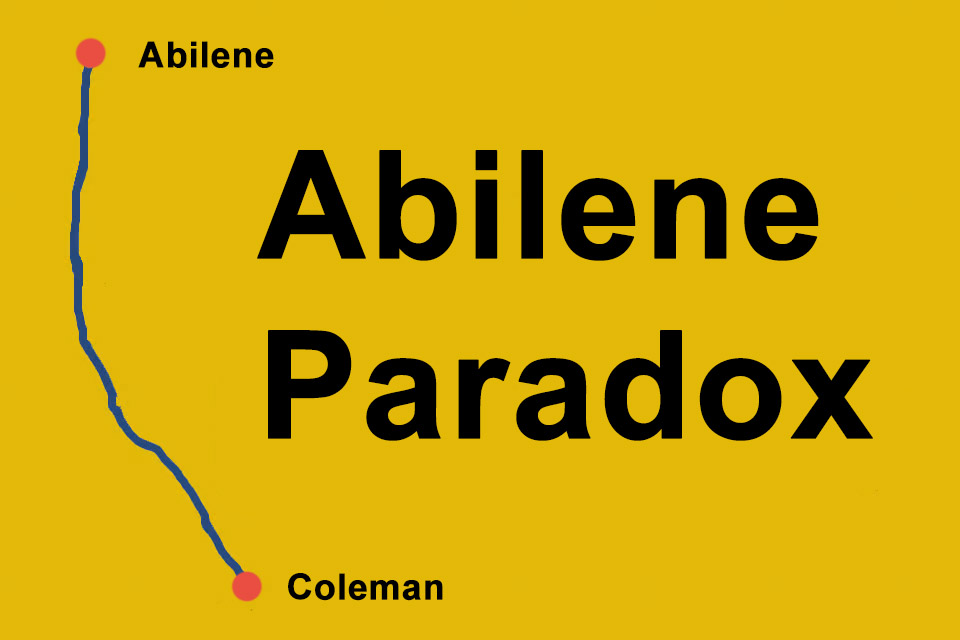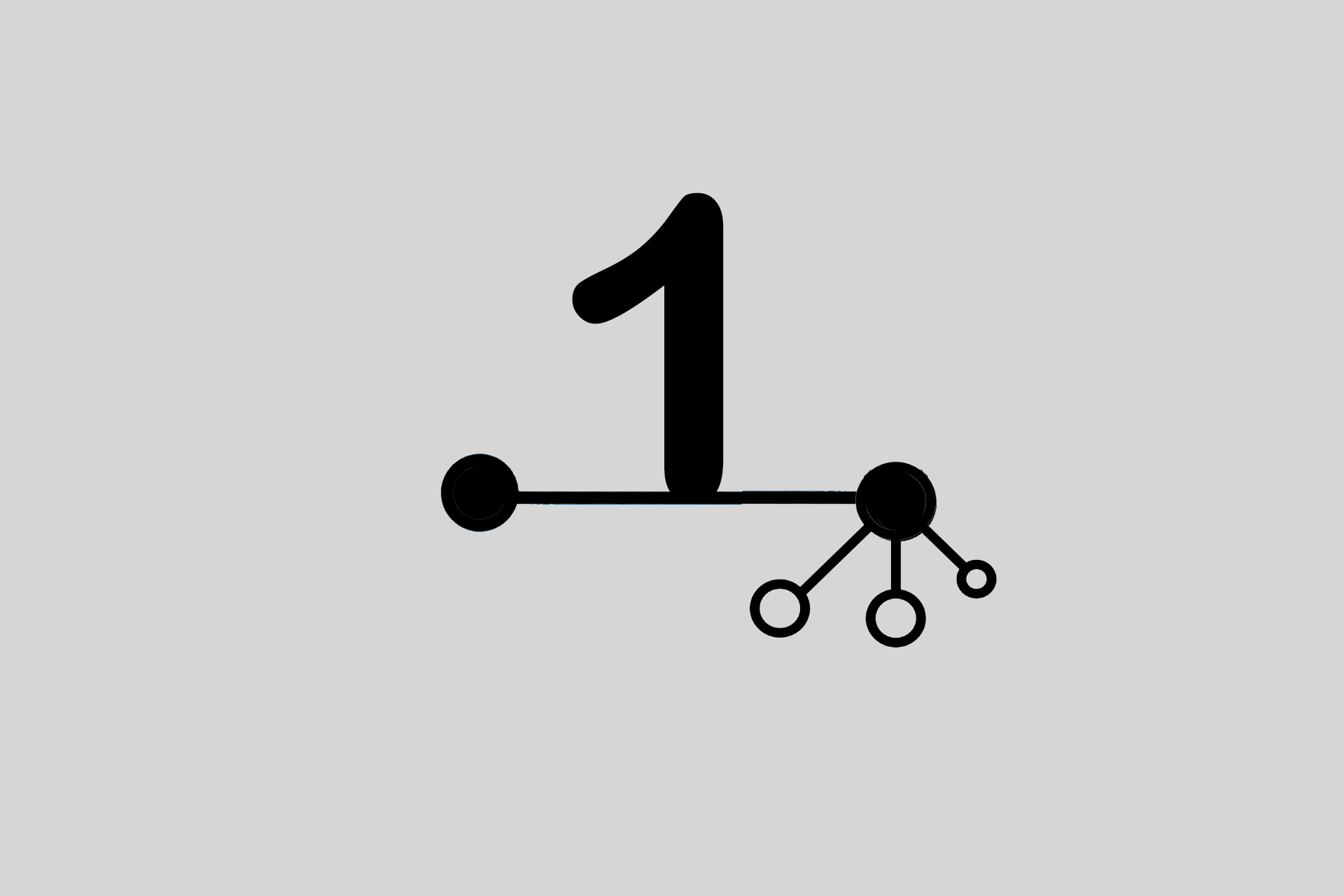What is Abilene Paradox?
Smartpedia: The Abilene Paradox is a group phenomenon in which a group decides to take one action even though individual, many or even all group members favour a different action.
Abilene Paradox – a group does something that the group members don’t want to do
Making “good” decisions in a group can be challenging, especially when the Abilene Paradox strikes. This paradox occurs when an action is initiated and carried out in a group even though individual, many or even all group members reject that action. The group with its members thus does something that the members do not like and do not want to do. “Blame” is placed on faulty group communication and the lack of ability to obtain genuine consent for an action.
The term Abilene Paradox comes from Jerry B. Harvey¹, a former professor of business administration at George Washington University. In an article² Harvey describes a situation where a family from Coleman, Texas, decides to drive to Abilene, 53 miles away, for dinner in an un-air-conditioned car in 40 degree temperatures. All family members (father-in-law, mother-in-law, wife and husband) agree, take the hot, dusty drive, only to arrive home four hours and a bad dinner later back at home. When asked, “It was a great trip, wasn’t it?” the mother-in-law replies, “To be honest, I didn’t enjoy it much and would have preferred to stay here. I only went along because you three were so enthusiastic about it. I wouldn’t have gone if you all hadn’t pushed me to go”. A discussion ensues, showing which family member had agreed to the excursion and with which assumption, and that in fact no one was in the mood for dinner in Abilene.
Symptoms of the Abilene Paradox
Harvey describes in his article that the reason for the Abilene Paradox is not the inability to manage conflict, but the inability to manage consent. He names 6 symptoms for this thesis:
- Each team member evaluates a situation individually for himself and subjectively (or only seemingly objectively) for the group.
- Each team member develops a solution for a situation or challenge that makes the most sense both individually and supposedly collectively.
- Team members fail to communicate their desires and/or beliefs to each other. In fact, they do just the opposite, misleading each other into a false perception of the collective reality. (Or as the father-in-law puts it: “I never really wanted to go to Abilene. I just thought you would be bored, and since you visit us so rarely, I wanted to make sure you enjoyed your visit. I would rather have played another game of dominoes and eaten the leftovers from the icebox”).
- Based on assumptions and inaccurate information, team members make decisions that lead them to take actions that are contrary to their actual intentions and desires individually but also collectively.
- As a result of the actions, group members experience frustration, anger, irritation and dissatisfaction with their organisation. Individual members form sub-groups with trusted people and blame other members, other sub-groups or authority figures for the dilemma.
- If a team or organisation does not address the general problem – the inability to reach agreement – the cycle repeats itself with greater intensity. Such situations can be observed in numerous projects, developments and/or organisations. As a result, dissatisfaction increases, more “bad” decisions are made, the success of projects is jeopardised, etc.
Measures against the Abilene Paradox
There are some steps or measures that work against the Abilene Paradox:
- It is extremely useful to explain the paradox to the group so that all group members understand the concept, they recognise it and they can avoid its impact.
- Real consensus (or consent), based on asking team members if they are really happy with the decision and they share the decision, helps.
- Non-verbal signs and expressions, facial expressions and gestures, allow us to recognise whether there is dissatisfaction with the group decision. And if there is, it is a good idea to ask benevolently and without any reservations about the reasons for the dissatisfaction.
- The conscious introduction of a devil’s advocate can help to reveal hidden reservations. By deliberately taking the opposite position – regardless of their own opinion – a person breaks the taboo on criticism and creates a safe space in which others can also dare to express doubts or concerns. This is how the dynamic of tacit consent can be actively broken.
Even if Jerry B. Harvey sees the essential cause of the Abilene Paradox in the inability to manage consent, a concern about conflict cannot be completely negated. Some people avoid conflict and consequently put their personal motives and agendas on the back burner; this is where facilitators and/or leaders are challenged to also include these people in a decision-making process and provide them with a space, safety and understanding. Without such support, group communication fails yet again.
Reinforcing reasons for the Abilene Paradox
There are also some aspects that reinforce the phenomenon besides the collective “misperception”:
- There is no individual polling of opinions, but one person decides “for” the group with the best of his or her knowledge and conscience.
- An attribution error occurs in which an individual assumption is transferred to the collective. This often happens unconsciously, for example through the use of beliefs or prejudices.
- Group polarisation ensures that individual views of individual group members become more “extreme” and thus reinforces the perceived group tendency.
- Groupthink occurs with individual opinions and views conforming to an expected, assumed group opinion.
A situation arises where a majority of a group secretly rejects a norm, but assumes that the majority of the group accepts it. This situation is also called pluralistic ignorance. - Forecasting error occurs whereby individual team members incorrectly forecast opinions, trends, intentions of other team members and subsequently for the whole team and adapt in anticipatory obedience.
- In a similar vein, so-called collective intelligence (also known as wisdom of the many) works, whereby individual team members rely on decisions made by others, assuming that a) most others do too and b) they are certainly the most sensible.
- And last but not least: enthusiasm. Often a team will follow a team member who is particularly enthusiastic about an idea or energetically promotes a specific decision.
Impulse to discuss
Can the paradox also be observed if a group member adds an additional person to a functioning WhatsApp/Signal group and from then on all other participants act more cautiously in the group?
If you like the article or would like to discuss it, please feel free to share it in your network. And if you have any comments, please do not hesitate to send us a message.
[1] Jerry B. Harvey
[2] The Abilene Paradox: The Management of Agreement
Similarities and differences between the Abilene Paradox and groupthink are discussed in various publications. Sometimes it is argued that there are different energy levels (low energy in the Abilene Paradox, energetic decisions in Groupthink), but this argumentation does not really seem valid. Certainly, both phenomena are related, certainly groupthink is better known as a concept and presumably the Abilene Paradox is a specific manifestation of groupthink.
Here you can find a video about The Abilene Paradox.
And here you will find additional information from the t2informatik Blog:



